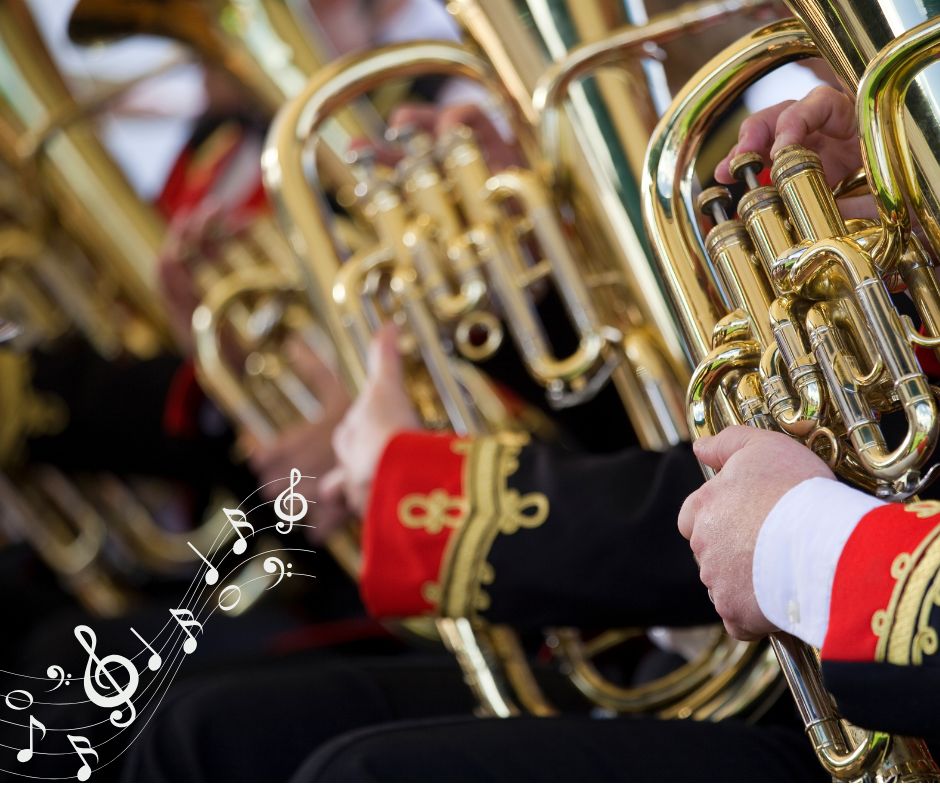
Exploring Bude Metric Brass Instruments
Exploring the Instruments of a British Brass Band
British brass bands have a rich and storied history, playing a key role in the UK’s musical tradition. From grand outdoor events to intimate concert performances, these ensembles are known for their distinctive sound and proud heritage. Brass bands are made up primarily of brass and percussion instruments, each contributing to the band’s vibrant, powerful tone. In this post, we’ll take a closer look at the instruments commonly found in a traditional British brass band and explore the vital roles they play.
The Core of the Band: Brass Instruments
At the heart of any brass band are the brass instruments. A typical British brass band consists of a range of brass instruments, each playing a unique part in the overall sound. These instruments are organised into sections: Soprano, Solo, First, Second and Third Cornet, Tenor Horns, Baritones, Trombones, Euphoniums and Bass.
Let’s take a look at each section and its instruments:
Soprano Cornet
The soprano cornet is the highest-pitched instrument in the brass band. Smaller and higher-pitched than the standard cornet, it is capable of playing very bright, sharp notes. The soprano cornet often carries the melody in faster, more lively pieces, and its bright sound helps it cut through the rest of the ensemble. Because of its high register, it requires a great deal of skill to play effectively, especially in more complex passages.
Cornet Section (Solo, First, Second & Third Cornets)
Cornets are the backbone of the brass band, providing both melody and harmony. The Solo and First Cornet play the lead part, often carrying the most prominent melodic lines. The Second and Third Cornet provide harmonic support, though they may also play melodic lines themselves, particularly in more intricate pieces. Cornets are similar to trumpets, but their conical shape gives them a mellower tone. This flexibility in sound allows the cornet section to adapt to a wide variety of musical styles.
Tenor Horns
The tenor horn section plays an important role in creating a warm, smooth sound. Positioned between the higher-pitched cornets and the lower-pitched euphoniums, the tenor horns provide a lyrical and melodic voice. Their rounded tone is often used for more expressive, lyrical passages, and they help to blend the sound of the band as a whole. Like the euphonium and baritone sections, they are versatile instruments, contributing to both melody and harmony.
Baritone Horns
Baritones are slightly smaller than euphoniums, but they have a similar role in the brass band. Their warm, mellow sound sits comfortably between the tenor and bass instruments. The Solo Baritone often carries the melody in softer or slower pieces, while the Second Baritone typically provides harmonic support. Their flexibility allows them to play both lyrical passages and provide rich harmony to balance the brighter tones of the cornets and soprano cornet.
Euphoniums
The euphonium is one of the most expressive instruments in the brass band, known for its rich, velvety sound. It plays a key role in the middle to lower ranges of the band. Euphoniums often provide the harmonic backbone of the band, supporting the melody played by the higher brass instruments. The Solo Euphonium is particularly important, taking the lead in many pieces with its smooth, lyrical tone. The euphonium’s ability to play both low, resonant notes and soaring high notes makes it an indispensable part of the brass band.
Trombones (Tenor and Bass)
Trombones are another essential section of the brass band, contributing both harmonic support and melodic lines. The Tenor Trombone is known for its distinctive slide mechanism, which allows for smooth glissandos and pitch bending. The Bass Trombone has a lower, deeper tone and helps anchor the band’s sound in the lower registers. Both instruments add depth and power to the brass band’s overall sound, often playing more dramatic or forceful sections of music.
Basses
The B-flat (Bb), double-B-Flat (BBb) and E-flat (Eb) basses play a crucial role as the foundation of the bands sound. These instruments, both types of tubas, provide the deep, resonant tones that anchor the harmonic structure and support the entire band. The BBb bass, the largest and deepest-pitched brass instrument in the band, delivers the lowest notes and contributes powerful, sonorous bass lines that establish the musical groundwork. The Eb bass, slightly smaller and pitched higher than the BBb, complements the lower tuba with a more agile sound that enriches the mid-to-low register and allows for greater melodic movement when required. Together, these bass instruments create a robust and cohesive bass section that enhances the fullness and depth of the band’s performance, ensuring a balanced sound that supports both harmony and rhythm.
The Backbone: Percussion Section
While brass instruments form the heart of the band, the percussion section provides the rhythm, drive, and dynamic contrast that bring the music to life. Percussion instruments help to maintain the beat, add excitement, and provide accents throughout the music.
The Role of the Conductor
Though not an instrument in the traditional sense, the conductor plays an essential role in guiding the brass band. The conductor is responsible for directing the ensemble, ensuring all instruments are in sync with one another, and shaping the performance. They provide cues for tempo, dynamics, and phrasing, helping the musicians to interpret the music as a unified whole. The conductor also keeps the musicians on track during complex or fast-moving sections, ensuring that the brass band sounds as cohesive and harmonious as possible.
The Sound of a British Brass Band
The sound of a British brass band is unmistakable—a blend of powerful brass tones and rhythmic percussion, with a vibrant, rich texture that can shift from the thunderous roar of the bass drum to the bright brilliance of the soprano cornet. The unique combination of brass and percussion instruments gives the British brass band its iconic sound, one that has become synonymous with British musical culture.





